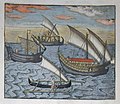English: De Bry, Johann Theodor, (1560-1623) and Johann Israel de Bry (1565-1609). Part III, Plate 28, Shown are Four Kinds of Ships Which the Bantenese Use. From the "Little Voyages"
ASIAN VESSELS IN BANTAM
The illustration shows four different types of vessel in the harbor of the trading town of Bantam on the northwestern tip of Java. The vessel on the right, with the high running aft and the two yards is called a iuncos in the journal, which is also called Junk, after the Javanese word Djong. Left we see a Chinese Junk. In the rear, there is a proa with a bowed prow and aft, used by the Javanese for trade along the coast. The foreground shows a proa with double outriggers. The Dutch called them 'kites', because they seemed to skim across the water so fast, it seemed as if they were flying.
Shown are four kinds of ships which the Bantamese use
The Indians have another four kinds of ships the one kind is big with two masts and sails. The other kind is slightly smaller so that they can transfer the wares from one place to another. The third kind are very small fishing boats which are so fast as if they could fly that's why we call them the flying. The ships sails are woven out of weed and are very popular in Bantam several are also made from leaves of the trees they also use pipes for the boat they don't have a back rudder they just use a hand paddle on each side which they can handle very skillfully.
Description from the
Cambridge History of Southeast Asia:
When the Dutch first arrived in the busy port of Banten at the close of the sixteenth century, they noted a number of boats which were common throughout the region. The first was the
perahu, a name which was generally used for a small undecked boat. At Banten the
perahu had a house-like structure built over part of the hull to serve as a shelter. It also had a large mainmast and a foremast with bamboo booms. The sails were made of a type of palm or rattan matting and sometimes even of woven palm leaves. Some six men sat in the front of the perahu and would row if necessary, while two men remained in the back to work the two rudders placed on either side of the boat. There was also a bamboo rudder under the middle of the perahu which was kept in place by a rope. There was another boat called the
katur which impressed the Dutch for its speed. It was a basic dug-out with a round keel, pointed bows, and a double outrigger. It had such a large sail that the Dutch marvelled that it did not overturn in the wind. There was also a trader called a
jong, which had a bowsprit and in some cases a forked mast, as well as a mainmast and a foremast. There was an enclosed upper deck stretching the whole length of the
jong, part of which formed a special cabin for the captain. Below the main deck were compartments where the goods were stowed, with access through two openings on either side of the ship. The capacity of the largest
jong which the Dutch saw in Banten was estimated to be not more than forty tonnes, though they commented that those from China and Pegu were far larger. (
Some parts translated from here)


